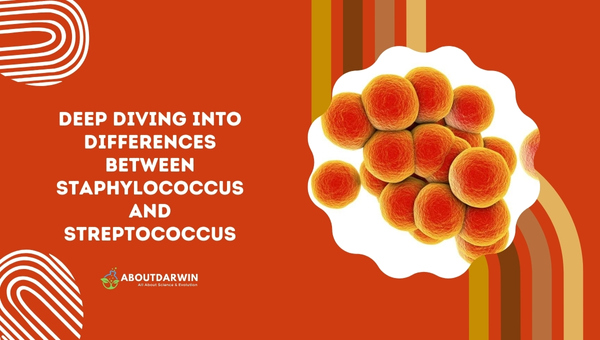Physical Address
304 North Cardinal St.
Dorchester Center, MA 02124
Welcome! Today, I want to bridge the gap of understanding between two commonly heard names in the microbial world – Staphylococcus and Streptococcus. These tiny organisms play huge roles in our health, making their way into everyday conversation in medical arenas and beyond.
In our journey through this article, we will untangle the myriad of characteristics that set these bacteria apart. We will delve into their structures, behaviors, and impacts on human health. Whether you’re a biology enthusiast or someone merely looking to increase your knowledge base, this guide will shed light on these fascinating micro-organisms. Let’s dive in!
Contents

Let’s take a look at how these two types of bacteria measure up in terms of some key aspects.
| Characteristics | Staphylococcus | Streptococcus |
|---|---|---|
| Shape | Spherical (Cocci) | Spherical (Cocci) |
| Gram stain | Gram Positive | Gram Positive |
| Arrangement | Alpha, Beta, and Gamma Hemolytic | Usually in Pairs or Chains |
| Oxygen Requirements | Facultative Anaerobes (Can live with or without oxygen) | Mostly Aerobic(Some are anaerobic or facultative anaerobes ) |
| Catalase Test | Positive | Negative |
| Hemolysis | Both Beta and Alpha Hemolytic | Alpha, Beta and Gamma Hemolytic |
| Pathogenic Strains | Staphylococcus aureus, Staphylococcus epidermidis | Streptococcus pneumoniae, Streptococcus pyogenes |
Remember, while they seem similar at first glance, the differences between them significantly impact how these microbes interact with our bodies and the diseases they cause.
Also Read: Salmonella Shigella (SS) Agar: Purpose, Principles and Uses
Staphylococcus, often referred to as “staph,” is a type of bacteria commonly found on the skin and in the nose of humans. They thrive in warm, moist areas like sweat glands and hair follicles but can also be present on colder, drier surfaces.
They’re round (cocci) and usually cluster together like grapes, which is why they earned their name- “Staphylococcus,” from the Greek staphylē (a bunch of grapes) and kokkos (a berry).
While many species are harmless, some can cause significant illnesses—these range from minor skin infections to life-threatening conditions like pneumonia, endocarditis, or toxic shock syndrome.
Staph infections are typically caused when the organism infiltrates open wounds or breaches other protective barriers of our body’s defense system. Some strains are prominent in healthcare settings, causing concern due to their resistance to many commonly used antibiotics.
Staphylococcus is a group of bacteria that, amazingly, we encounter in our everyday life. They predominantly inhabit the human skin and mucous membranes, silently co-existing with us without causing trouble most of the time. Common places where these buggers hang out include our nasal passages and on our skin, especially in moist areas such as the armpits and groin area.
However, when given a chance to enter the body—say through a cut or during a surgical procedure—these bacteria might seize the opportunity to cause infections. Staphylococcus thrives in conditions where your immune system is compromised or when there’s an open wound serving as an entry point into your body.
From minor skin infections to life-threatening diseases such as pneumonia or bloodstream infections, Staphylococcus truly shows that it is not about size but the impact one can make—even if you’re just a microbe!
When you get up close and personal, you’ll notice that Staphylococcus has some distinct traits. First off, they are gram-positive bacteria. If you’re scratching your head wondering what that means, it refers to how these bacteria react to a certain stain used in the lab—named Gram stain after the scientist Hans Christian Gram.
Now, let’s get to their shape and arrangement. They are spherical (or coccus) in form and tend to hang out together in ‘bunch of grapes’-like clusters, giving us the name staphylococcus – ‘staphyle’ meaning bunch of grapes and ‘coccus’ meaning spherical in Greek.
Through a microscope, these clusters look less like threatening disease-causing agents and more like cheeky chappies huddling for a group selfie!
The interesting thing about Staphylococcus is that it’s not always the bad guy. While some strains are completely harmless, others have a darker side. For instance, Staphylococcus aureus, one of the most dreaded members of its family, is known to cause a gamut of ailments – from skin conditions like boils and impetigo to more serious infections such as pneumonia and meningitis.
The potency doesn’t stop there, though. Some strains of Staphylococcus aureus have become alarmingly resistant to antibiotics, like the infamous MRSA (Methicillin-Resistant Staphylococcus Aureus).
Infections caused by MRSA are harder to treat and thus can be especially dangerous. Whether it’s a tiny pimple or a life-threatening septicemia—or blood poisoning—Staphylococcus plays many roles in human pathology in a haunting microbiological theater!
Also Read: Simmons Citrate Agar: A Deep-Dive into Composition & Uses
When it comes to Streptococcus, another surprisingly common resident of our body, things get a bit more complex. There are multiple species of streptococcus bacteria, and they’re quite diverse in their characteristics and the effects they can have on us. You’ll find them hanging out in many places; they’re especially fond of the respiratory tract and your skin.

Despite their omnipresence, most Streptococcus bacteria are harmless, living quietly without bothering their host.
However, similar to Staphylococcus, certain members of the group can cause a variety of illnesses ranging from mild throat infections – to strep throat. – yes, that’s them! to severe conditions like rheumatic fever. So, while these guys might be microscopic, you probably don’t want to get on their bad side!
Streptococcus is another group of bacteria that typically coexists with us in our bodies. These microbes often reside harmlessly in the mouth, throat, nose, intestines, and on the skin. Some are even part of our gut flora and contribute to maintaining a balanced microbiome ecosystem within us.
However, it’s not all good relations with these inhabitants. Under certain conditions or when they invade deeper parts of the body, including the bloodstream or lungs, some Streptococcus strains can cause serious health problems. From tooth decay to more severe conditions like pneumonia or meningitis – this quiet resident sometimes shows its nasty side, too!
Streptococcus bacteria are somewhat of a puzzle in the microbial world. One key trait that aids in their identification is their gram-positive nature. This means they hold a thick layer of a specific substance called peptidoglycan in their cell walls, causing them to turn purple under a Gram stain test – a standard procedure employed in microbiology labs.
Adding to their intriguing profile is their distinctive shape and arrangement. Streptococcus bacteria are spherical or oval, but unlike their staphylococcal counterparts, they organize themselves in chains or pairs.
The name “strepto-” actually translates as “twisted” or “chain”. Little can one expect that such seemingly minute characteristics play crucial roles when it comes to dealing with these microscopic beings!
Streptococcus may sound innocuous, but certain strains can lead to a variety of illnesses. Notorious among them is Streptococcus pneumoniae, which is responsible for causing pneumonia–a severe lung infection. This strain can also cause ear and sinus infections, meningitis, and even sepsis if it finds its way into the bloodstream.
On the other hand, we have the group A Streptococcus or GAS. This nasty little strain is on another level, as it’s behind several infamous diseases like strep throat and scarlet fever.
If untreated, GAS can bring about rheumatic fever that might lead to heart problems or cause necrotizing fasciitis—more commonly known as ‘flesh-eating disease.’ Truly, depending on their strain type and how they enter our body, Streptococcus demonstrates a vast repertoire of health disturbances they’re capable of!
It’s worth noting that due to their differences in resistance patterns, treatment approaches may not work similarly for all cases involving Staphylococcus and Streptococcus. Seeking medical advice early for accurate diagnosis offers the best chance for a successful recovery.
Also Read: Exploring TCBS Agar: Composition, Uses and Preparation
A healthy person can carry these bacteria on or in their bodies without getting sick. These people are known as carriers; the bacteria live harmlessly unless our immune systems are weakened or if they gain access to normally sterile parts of our bodies.
Certain antibiotics are effective against Staphylococcus but not Streptococcus or vice versa because these two types of bacteria have different cell wall structures and metabolic processes that influence antibiotic susceptibility.
Some common diseases caused by Staphylococcus include skin infections, pneumonia, and food poisoning, while Streptococcus can cause strep throat, scarlet fever, and rheumatic fever.
The key difference between Staphylococcus and Streptococcus is their arrangement under the microscope; Staphylococcus bacteria are grouped in clusters, while Streptococcus bacteria line up in chains.
Also Read: Unraveling Potato Dextrose Agar (PDA): Principle & More
In our exploration of Staphylococcus and Streptococcus, we’ve delved into the microscopic world of these ubiquitous bacteria, understanding their diverse characteristics, habitats, and the diseases associated with them. I hope this journey has helped you comprehend the subtle but significant differences that set these two bacterial genera apart.
Let’s remember that despite their potential for causing disease, Staphylococcus and Streptococcus are an integral part of our world.
With advances in medical science, we can better manage the health risks associated with them while acknowledging their role in our environment. Learning and understanding about these bacteria is a stepping stone towards fostering a safer, healthier future for all.